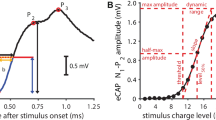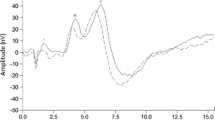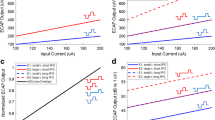Abstract
The eighth nerve compound action potential (CAP) in 95 guinea pigs was measured using click stimuli to investigate age-related changes in their neural auditory thresholds. The animals were separated into three groups: group A (n = 43, 86 ears; 2–4 months old); group B (n = 29; 58 ears, 13–15 months old); and group C (n = 23; 46 ears, 23–25 months old). With increasing age, a gradual elevation of CAP thresholds was clearly seen among the three groups. The negative peak (N1) latencies of the CAP were prolonged, and the N1 amplitudes of the CAP decreased. There were significant differences in N1 latencies among the three groups and in N1 amplitudes between groups A and B, and between groups A and C. However, the rate of decline of the thresholds as well as the input-output function curves of the CAP varied in some of the oldest animals, suggesting that there were some individual differences in degenerative aging processes of the auditory system.
Similar content being viewed by others
References
Anniko M (1988) The aging cochlear hair cell. Scanning Microsc 2:1035–1044
Axelsson A (1971) The cochlear blood vessels in guinea pigs of different ages. Acta Otolaryngol (Stockh) 72:172–181
Bleicher N (1965) Care of animals during surgical experiments. Methods of animal experimentation. Academic Press, New York
Coleman JW (1976) Hair cell loss as a function of age in the normal cochlea of the guinea pig. Acta Otolaryngol (Stockh) 82:33–40
Covell WP, Rogers JB (1957) Pathological changes in the inner ears of senile guinea pigs. Laryngoscope 67:118–129
Crowley DE, Schramn VL, Swain RE, Maisel RH, Rauchback E, Swanson SN (1972) An animal model for presbycusis. Laryngoscope 72:2079–2091
Dayal VS, Barek WG (1975) Cochlear changes from noise, kanamycin, and ageing. Laryngoscope 85:1–18
Dum N (1983) Age-dependent changes of the compound action potential in the guinea pig. Arch Otorhinolaryngol 238:179–187
Dum N, Schmidt U, Wedel H (1980) Age-related changes in the auditory evoked potentials of albino and pigmented guinea pigs. Arch Otorhinolaryngol 228:249–254
Dum N, Schmidt U, Wedel H (1980) Age-dependence of the neural and auditory thresholds of albino and pigmented guinea pigs. Arch Otorhinolaryngol 229:191–199
Etholm B, Belal A Jr (1974) Senile changes in the middle ear joints. Ann Otol Rhinol Laryngol 83:49–54
Ikeda K, Kusakari J, Kawamoto K (1987) N1 latency prolongation in the guinea pig cochlea treated with nitrogen mustard-N-oxide studied by narrow band analysis. Ann Otol Rhinol Laryngol 96:182–186
Jewett DL (1970) Volume-conducted potentials in response to auditory stimuli as detected by averaging in the cat. Electroencephalogr Clin Neurophysiol 28:609–618
Keithley EM, Feldman ML (1979) Spiral ganglion cell counts in an age-graded series of rat cochleas. J Comp Neurol 188:429–442
Keithley EM, Feldman ML (1982) Hair cell counts in an age-graded series of rat cochleas. Hear Res 8:249–262
Murakami Y (1991) Hearing loss in the aged: presbycusis (in Japanese). Yamanashi Med J 6:83–90
Nakanishi T, Yoshie N (1989) Evoked potentials in clinical medicine. Nankodo, Tokyo
Otto WC, McCandless GA (1982) Aging and the auditory brain stem response. Audiology 21:466–473
Pestallozza G, Davis H, Eldredge DH, Covell WP, Rogers JB (1957) Decreased bio-electric potentials in the ears of senile guinea pigs. Laryngoscope 67:1113–1122
Rosenhamer HJ, Lindstorm B, Lundborg T (1980) On the use of click-evoked electric brainstem responses in audiological diagnosis: the influence of sex and age upon the normal response. Scand Audiol 9:93–100
Rowe M (1980) Normal variability of brainstem auditory evoked response in young and old adult subjects. Electroencephalogr Clin Neurophysiol 44:459–470
Salvi R, Henderson D, Hamernick RP, Parkins C (1980) VIII nerve response to click stimuli in normal and pathological cochleas. Hear Res 2:335–342
Schuknecht HF, Gacek MR (1993) Cochlear pathology in presbycusis. Ann Otol Rhinol Laryngol [Suppl] 158:1–16
Simpson GV, Knight RT, Brailowsky S, Prospero-Garcia O, Scabini D (1985) Altered peripheral and brainstem auditory function in aged rats. Brain Res 348:28–35
Ulehlova L (1975) Aging and the loss of neuroepithelium in the guinea pig. Adv Exp Med Biol 53:257–264
Author information
Authors and Affiliations
Rights and permissions
About this article
Cite this article
Nozawa, I., Imamura, S., Hashimoto, K. et al. Age-related changes in the compound action potentials of the eighth nerve in guinea pigs. Eur Arch Otorhinolaryngol 254, 145–149 (1997). https://doi.org/10.1007/BF02471279
Received:
Accepted:
Issue Date:
DOI: https://doi.org/10.1007/BF02471279




